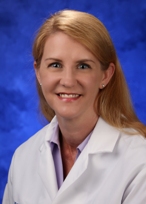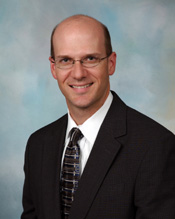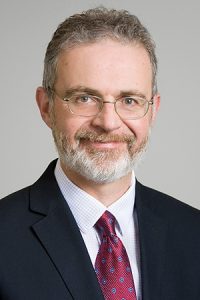COVID-19 has had a major impact on everyone and it likely will be a long time before we return to normal activities. Here are three diplomates’ accounts of how the novel coronavirus has affected their workplaces and professional lives.
Karen L. Brown, MHP, CHP
Diagnostic Imaging Physicist, MR Safety Officer
Senior Instructor of Radiology
Penn State College of Medicine
 “We delayed nonessential testing of equipment during the height of the COVID pandemic. This was done to minimize risk to our staff and to maximize availability of imaging equipment for use in managing COVID patients. We also worked collaboratively with our radiologist and technologist colleagues to develop innovative ways to image potential COVID patients through Plexiglas shields. This helped minimize risk to the imaging staff and minimize the need for lengthy equipment decontamination procedures.
“We delayed nonessential testing of equipment during the height of the COVID pandemic. This was done to minimize risk to our staff and to maximize availability of imaging equipment for use in managing COVID patients. We also worked collaboratively with our radiologist and technologist colleagues to develop innovative ways to image potential COVID patients through Plexiglas shields. This helped minimize risk to the imaging staff and minimize the need for lengthy equipment decontamination procedures.
“During the height of the pandemic, we rotated shifts on a one-week in-hospital, one-week work-from-home basis. At this point we are resuming normal operations and are at approximately 80 percent of our pre-COVID patient volumes. We have returned to normal schedules and operations.”
Matthew Podgorsak, PhD
Chief Physicist
Department of Radiation Medicine
Roswell Park Cancer Institute
“Early in the pandemic, we instituted best practices recommended by the CDC to keep our patients and staff safe. This included patient and staff screening (family members were not permitted in our clinic areas), universal mask-wearing, enhanced cleaning of immobilization devices and all surfaces that touch a patient, and limiting the number of staff within enclosed spaces.
“Our institute leadership prohibited work-related travel and strongly encouraged any personal travel to be postponed. Our department also instituted work-from-home policies that enabled us to lower the density of staff within our department but, nonetheless, continue with our clinical operations. Our patient peer-review conferences were all transitioned to virtual meetings, and our academic teaching was also done virtually. Patient consultations and clinic visits were also mostly virtual during the peak of the pandemic, although these are slowly transitioning back to more in-person visits with health-care practitioners.
“Throughout the pandemic, we continued to treat all patients who were referred to us. Very few patients, if any, had their fractionation schedules shortened or altered as a result of the pandemic. We did increase our treatment timeslots to lower the number of patients in our clinic at any given time and to provide added time between patients to clean equipment. At the lowest, our patient volume dipped to about 60 percent of our pre-pandemic daily treatments, and we are seeing a slow rise toward our usual census, although as of the end of June we are still only at 75 percent of our usual daily treatments.
“With our community reaching the final phase of the re-opening process, we continue to screen all patients and staff who enter our facility, we continue with universal mask-wearing, and we continue to have social distancing requirements in our clinical areas, and, consequently, we have not yet transitioned back to a full-staff on-site presence. Work travel remains prohibited. It will be quite a while, I think, before we relax the changes implemented as a result of coronavirus. Some changes may remain permanent.”
Robert Pooley, PhD
Assistant Professor
Mayo Clinic
 “The primary effect of the COVID-19 pandemic on my everyday work has been related to the implementation of masking and distancing safety precautions and a shift to remote interaction with staff and trainees. Almost instantaneously, all face-to-face meetings at my institution and off-site were rescheduled as virtual meetings or canceled. To reduce the number of employees on campus, the declaration that ‘all work that can be done at home must be done at home’ had immediate impact. However, there was no limitation for work that could only be done on campus as long as screening, masking and distancing safety precautions were employed. Scheduled work that needed to be done on equipment was rescheduled for a later time if possible. The shift to virtual meetings and remote work from home went very smoothly as the infrastructure was already in place to accommodate this. It has been interesting to experience the positive impact of using video in virtual meetings rather than audio only. When possible, we use video to see our colleagues, and while this is not the same as an in-person meeting, the visual cues add an important social dynamic over audio-only meetings.
“The primary effect of the COVID-19 pandemic on my everyday work has been related to the implementation of masking and distancing safety precautions and a shift to remote interaction with staff and trainees. Almost instantaneously, all face-to-face meetings at my institution and off-site were rescheduled as virtual meetings or canceled. To reduce the number of employees on campus, the declaration that ‘all work that can be done at home must be done at home’ had immediate impact. However, there was no limitation for work that could only be done on campus as long as screening, masking and distancing safety precautions were employed. Scheduled work that needed to be done on equipment was rescheduled for a later time if possible. The shift to virtual meetings and remote work from home went very smoothly as the infrastructure was already in place to accommodate this. It has been interesting to experience the positive impact of using video in virtual meetings rather than audio only. When possible, we use video to see our colleagues, and while this is not the same as an in-person meeting, the visual cues add an important social dynamic over audio-only meetings.
“Initially, there was a period of six weeks in which nonemergent, scheduled patient procedures and imaging exams were rescheduled for a later date to reduce the number of patients and employees on campus. This has since been reversed and our patient volumes are nearly back to pre-COVID-19 levels. As we understand better the impact of this pandemic on our local community and have implemented mandatory safety precautions for all employees, patients and visitors, we are able to operate at full capacity and maintain full safety for everyone.”



